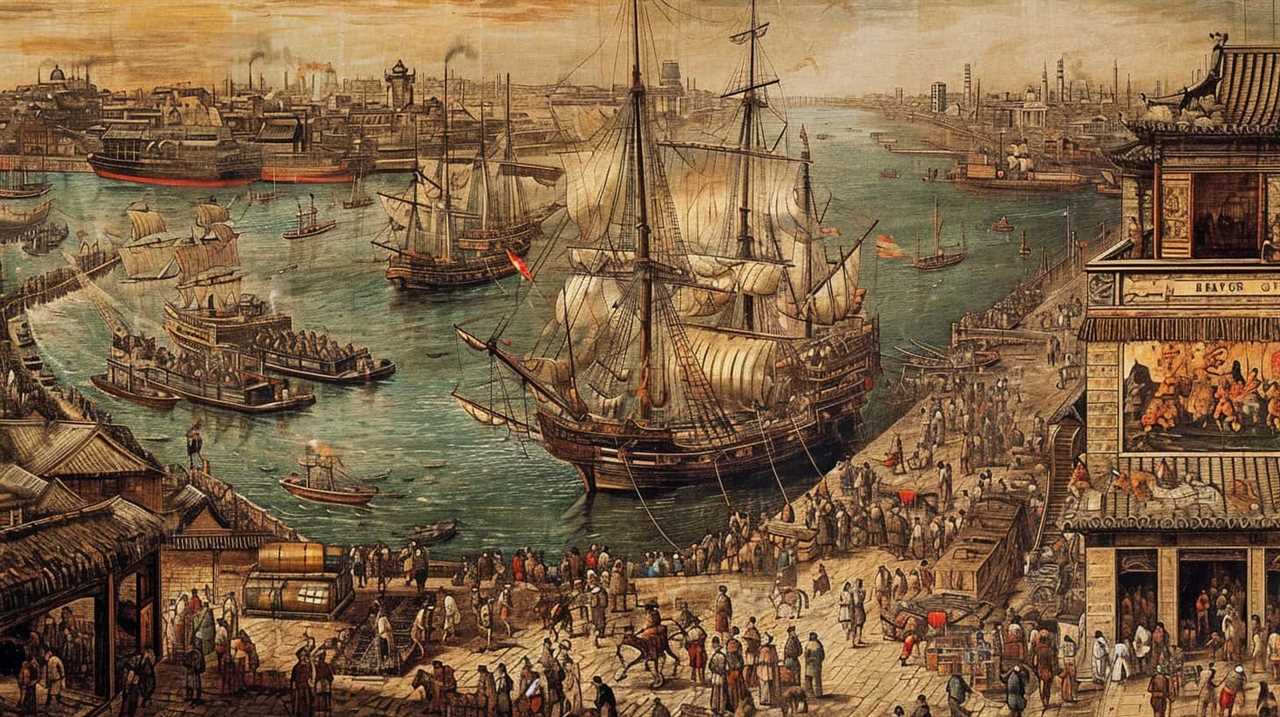Upon initial inspection, it may appear contradictory that the trade philosophies of a deceased economist could significantly influence the development of present-day economies. However, as we explore the groundbreaking concepts of David Ricardo, we discover a realm of innovation and potential.
Ricardo’s concept of comparative advantage, which highlights the benefits of specialization and trade, has transformed the landscape of international commerce. By embracing this principle, economies have witnessed a shift in global production patterns, leading to increased efficiency and competitiveness.
Moreover, Ricardo’s principles have influenced economic growth, income distribution, and long-term implications for nations. In this exploration, we will unravel how Ricardo’s trade principles have not only shaped economies but also paved the way for a future of endless possibilities.
Key Takeaways
- Comparative advantage theory explains how countries benefit from specializing in goods and services with lower opportunity costs.
- Specialization maximizes output and resource allocation.
- Tariffs and protectionism disrupt the benefits of international trade.
- Ricardo’s trade principles promote long-term prosperity for economies.
The Concept of Comparative Advantage
In our analysis, we frequently observe how the concept of comparative advantage, as explained by Ricardo, actively shapes economies. Comparative advantage refers to the ability of a country to produce a good or service at a lower opportunity cost than another country. This principle emphasizes that countries should specialize in producing goods or services in which they’ve a comparative advantage and trade with other countries to maximize overall production and consumption.

By considering opportunity cost, countries can identify the most efficient allocation of resources. For example, if Country A can produce both wheat and cotton at a lower opportunity cost than Country B, it makes sense for Country A to specialize in producing wheat and Country B to specialize in producing cotton. Through trade, both countries can acquire the goods they need at a lower cost than if they were to produce them domestically.
However, trade barriers such as tariffs and quotas can hinder the benefits of comparative advantage. These barriers restrict the flow of goods and services between countries, leading to higher prices and reduced consumer choices. By removing trade barriers, countries can fully harness the benefits of comparative advantage and foster innovation and competition.
In the subsequent section, we’ll explore the impact of comparative advantage on international trade and how it can drive economic growth and development.
Impact on International Trade
The impact of Ricardo’s trade principles on international trade is significant and far-reaching.

One key point is the concept of global market integration, which Ricardo’s theory of comparative advantage promotes. This theory suggests that countries should specialize in producing goods and services in which they’ve a comparative advantage, and then engage in trade with other countries to maximize overall economic welfare.
However, the implementation of tariffs and protectionism can disrupt the benefits of international trade, hindering economic growth and efficiency.
Global Market Integration
By actively participating in global market integration, we shape the impact of international trade on economies.
Ricardo’s trade principles, such as comparative advantage and specialization, play a crucial role in facilitating economic integration and development.

Through the integration of markets, countries can access a wider range of goods and services, leading to increased efficiency and productivity. This integration allows for the flow of capital, technology, and knowledge across borders, fostering innovation and promoting economic growth.
Additionally, global market integration encourages competition, which drives businesses to improve their products and services, benefiting consumers worldwide.
However, it’s important to note that global market integration can also pose challenges, such as the risk of economic dependency and the need for effective regulatory frameworks.
Nonetheless, when guided by Ricardo’s trade principles, global market integration can contribute significantly to economic development and prosperity.

Comparative Advantage Theory
Applying Ricardo’s trade principles, we shape economies through the impact of comparative advantage theory on international trade. Comparative advantage theory is a conceptual framework that explains how countries can benefit from specializing in the production of goods and services for which they have a lower opportunity cost. This theory has a profound effect on trade patterns worldwide, leading to increased efficiency and productivity. By focusing on producing goods and services in which they have a comparative advantage, countries can maximize their output and allocate resources more effectively. This results in a more interconnected global market, where countries specialize in different industries and engage in mutually beneficial trade. Comparative advantage theory has revolutionized international trade and continues to shape economies by promoting specialization and facilitating global economic growth.
| Column 1 | Column 2 | Column 3 | Column 4 |
|---|---|---|---|
| Concept | Trade | Comparative | Global |
| Framework | Patterns | Advantage | Market |
Tariffs and Protectionism
Continuing our analysis of Ricardo’s trade principles, let’s now delve into the impact of tariffs and protectionism on international trade.
Tariffs, which are taxes imposed on imported goods, can have significant implications for employment and the political landscape of a country.
On one hand, tariffs can protect domestic industries by making imported goods more expensive, which can lead to increased employment opportunities. However, this protectionist measure can also result in higher prices for consumers and reduced competitiveness in the global market.

Additionally, tariffs can lead to retaliatory actions from other countries, sparking trade wars and further disrupting international trade.
The political implications of tariffs are also noteworthy, as they can be used as a bargaining tool in negotiations between nations.
It’s crucial to carefully consider the impact of tariffs and protectionism on employment and political relationships in order to foster innovation and sustainable economic growth.
Shifting Patterns of Global Production
We observe significant changes in the patterns of global production as economies adapt and evolve. These changes are driven by various factors, including advancements in technology, shifts in consumer demand, and changes in government policies.

Here are three key aspects of the shifting patterns of global production:
- Global Supply Chains: With the advent of technology and improved transportation networks, global supply chains have become increasingly interconnected. Companies now source raw materials, components, and services from different countries to create their final products. This has led to a more efficient allocation of resources and increased specialization in production.
- Industrial Restructuring: As economies develop and mature, there’s often a need for industrial restructuring. This involves the reallocation of resources from declining industries to emerging sectors. For example, the rise of digital technology has led to a shift from traditional manufacturing industries to the development of software and other digital products.
- Regionalization: While globalization has allowed companies to expand their operations globally, there’s also a trend towards regionalization. This is driven by factors such as proximity to markets, reduced transportation costs, and the desire to establish closer relationships with suppliers and customers. Regional production networks are becoming more common, particularly in industries such as automotive and electronics.
These shifting patterns of global production have important implications for economies around the world. They require businesses to be agile and adaptable, and governments to create policies that support innovation and competitiveness.
Influence on Economic Growth
Through the application of Ricardo’s trade principles, we can observe how global production patterns influence the economic growth of nations. One key factor that affects economic growth is the inflation rate. Ricardo’s principles promote the idea that countries should specialize in producing goods and services in which they’ve a comparative advantage. This specialization leads to increased efficiency and productivity, which can help control inflation. When countries focus on producing goods they’re most efficient at, it reduces the overall cost of production. As a result, prices remain stable, and inflation rates are kept in check.
Another important aspect influenced by Ricardo’s trade principles is fiscal policy. Ricardo argued that countries shouldn’t impose trade barriers such as tariffs and quotas. By allowing free trade, nations can benefit from the advantages of specialization and comparative advantage. This opens up opportunities for increased trade, leading to economic growth. Additionally, the absence of trade barriers encourages competition, which can drive innovation and productivity.

Effects on Income Distribution
When examining the effects of Ricardo’s trade principles on income distribution, several key points come to light.
Firstly, the concentration of wealth plays a significant role in shaping income distribution, with trade often exacerbating the divide between the rich and the poor.
Secondly, the implications of social inequality can’t be overlooked, as trade can deepen existing disparities and create new ones within societies.
Lastly, the consideration of redistribution policies becomes crucial in addressing the potential negative impacts on income distribution caused by Ricardo’s trade principles.

Wealth Concentration Impact
Our analysis of Ricardo’s trade principles reveals the significant impact of wealth concentration on income distribution. Understanding this impact is crucial for addressing issues of income inequality and poverty reduction.
Here are three key ways in which wealth concentration affects income distribution:
- Widening income gap: When wealth becomes concentrated in the hands of a few, it leads to a wider income gap between the rich and the poor. This exacerbates income inequality and hinders efforts to reduce poverty.
- Limited economic mobility: Wealth concentration can hinder upward economic mobility for those at the bottom of the income distribution. Limited access to resources and opportunities can make it difficult for individuals to improve their economic situation and escape poverty.
- Political influence: Concentrated wealth often translates into concentrated political power. This can result in policies that favor the wealthy, further exacerbating income inequality and hindering poverty reduction efforts.
Addressing wealth concentration is essential for creating a more equitable society and promoting inclusive economic growth. By implementing policies that promote fair wealth distribution and equal opportunities, we can work towards a more balanced income distribution and a society that fosters innovation and prosperity for all.
Social Inequality Implications
We explore how social inequality shapes income distribution in economies influenced by Ricardo’s trade principles.

Social inequality refers to the unequal distribution of resources, opportunities, and wealth among individuals in a society.
In these economies, the wealth gap is often widened, leading to significant disparities in income. The concentration of wealth in the hands of a few can limit social mobility for those at the lower end of the income distribution, making it difficult for them to improve their economic situation.
As a result, income distribution becomes more skewed, with a small portion of the population accumulating a large share of the wealth. This has implications for social cohesion and economic stability.
Transitioning into the subsequent section on redistribution policy considerations, it’s crucial to address these issues to ensure a more equitable distribution of resources.

Redistribution Policy Considerations
Continuing from the previous subtopic, we can examine the effects of redistribution policies on income distribution in economies shaped by Ricardo’s trade principles. Redistribution policies play a crucial role in addressing social inequality and promoting social welfare.
Here are three key considerations:
- Targeted Approach: Effective redistribution policies should be designed to specifically target the most vulnerable and disadvantaged groups in society. By focusing on those who are in most need, these policies can effectively reduce income disparities and improve social welfare outcomes.
- Incentive Structures: It’s important to carefully consider the impact of redistribution policies on individual incentives. While the goal is to promote fairness and equality, overly generous redistribution policies may discourage individuals from working hard and contributing to economic growth. Striking the right balance is essential to ensure both social welfare and economic prosperity.
- Long-Term Sustainability: Sustainable redistribution policies require careful planning and consideration of their long-term effects on the economy. It’s important to avoid measures that create dependency or hinder economic productivity. Instead, policies should strive to create opportunities for upward mobility and empower individuals to improve their own economic situation.
Long-term Implications for Economies
The long-term implications for economies can be understood by analyzing the effects of Ricardo’s trade principles. One important aspect to consider is income mobility.
Ricardo’s principles, such as comparative advantage and specialization, lead to increased trade and economic growth. This growth can result in higher incomes for individuals, which in turn can promote upward income mobility.

By allowing countries to focus on their comparative advantages and specialize in certain industries, Ricardo’s principles enable economies to become more efficient and productive. This can lead to the creation of new jobs and opportunities for workers, thus increasing their chances of upward mobility.
Additionally, Ricardo’s trade principles have a significant impact on technological advancements. When countries specialize in certain industries, they’re more likely to invest in research and development to improve productivity and competitiveness. This drive for innovation can lead to the development of new technologies, which can have long-term benefits for economies.
Technological advancements can result in increased productivity, reduced costs, and the creation of new industries and markets. These advancements can further stimulate economic growth and promote long-term prosperity.
Frequently Asked Questions
How Did Ricardo’s Trade Principles Initially Develop and Gain Popularity?
Ricardo’s trade principles initially developed and gained popularity due to their ability to foster global economic stability and strengthen geopolitical relationships. These principles revolutionized the way nations engage in trade and continue to shape economies worldwide.

What Are Some Specific Examples of Countries That Have Successfully Applied Ricardo’s Trade Principles and Experienced Economic Growth as a Result?
Examples of countries that have successfully applied Ricardo’s trade principles and experienced economic growth include Singapore, South Korea, and Taiwan. These nations have prioritized free trade, specialization, and comparative advantage, leading to increased exports and improved living standards.
Are There Any Potential Drawbacks or Limitations to the Concept of Comparative Advantage?
There are potential drawbacks and limitations to the concept of comparative advantage. Drawbacks include dependency on other nations and potential job displacement. Limitations arise from assumptions that may not always hold true in the real world.
How Do Shifting Patterns of Global Production Impact the Job Market and Employment Opportunities in Different Countries?
Shifting patterns of global production have a significant impact on the job market and employment opportunities worldwide. As industries relocate or outsource, it alters the labor landscape, creating both challenges and new possibilities for workers in different countries.
Can You Provide Any Insights Into the Potential Long-Term Implications of Ricardo’s Trade Principles on Global Economic Stability and Geopolitical Relationships?
The potential long-term implications of Ricardo’s trade principles on global economic stability and geopolitical relationships are significant. These principles, such as comparative advantage and specialization, shape economies by promoting efficient allocation of resources and fostering international trade.

What Impact Did Thomas Mun’s Trade Philosophy Have on Ricardo’s Trade Principles and Economies?
Thomas Mun’s trade philosophy decoded greatly influenced Ricardo’s trade principles and economies. Mun emphasized the importance of a favorable balance of trade, which Ricardo used as a basis for his theory of comparative advantage. This had a significant impact on trade policies and economic growth, shaping the modern global economy.
Conclusion
In conclusion, Ricardo’s trade principles have undoubtedly shaped economies by promoting the concept of comparative advantage. This concept has influenced international trade and shifted global production patterns.
While these principles have undoubtedly contributed to economic growth, their effects on income distribution and long-term implications for economies can’t be ignored.
It’s fascinating to observe how Ricardo’s ideas continue to shape our globalized world. Even if we can’t help but chuckle at the complexities and intricacies of economic theory.
Lauren’s talent in writing is matched by her passion for storytelling. Her love for books and deep understanding of culture and entertainment add a distinct flavor to her work. As our media and press contact, Lauren skillfully bridges the gap between afterQuotes and the broader media landscape, bringing our message to a wider audience.










